Publications
Nieman Reports
Highlights from Nieman Reports this year include two significant cover packages by 2017 Nieman Fellow Katherine Goldstein, the first examining the lack of support for mothers in newsrooms and the second on the news industry’s sexual harassment problem.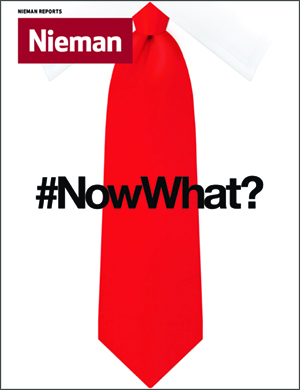
Published in the wake of the Harvey Weinstein case, a cascade of sexual harassment allegations, and the ouster of numerous men in the media, “The News Industry Has a Sexual Harassment Problem. #NowWhat?,” provided a road map for what needs to change in newsrooms. Goldstein makes the case that hiring more women in leadership positions would help set a better tone and making nondisparagement agreements illegal would take away a tool companies have used to silence victims of sexual harassment. The cover story was accompanied by a column by Nieman curator Ann Marie Lipinski and vignettes by eight reporters—including Glenn Whipp of the LA Times, Gabriel Sherman of Vanity Fair and Emily Steel of The New York Times—all reflecting on the challenges of covering sexual harassment.
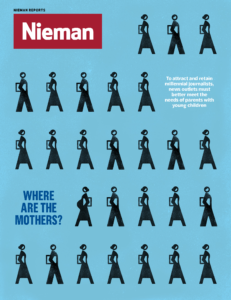 “Where Are the Mothers?,” published in the summer, made the case that if news organizations want to attract and retain talented, diverse groups of journalists—including young mothers—they must work to better meet the needs of parents and create better work-life balance for all employees. “Where Are the Mothers?” was recognized by a number of media outlets. Goldstein was a guest on the “Reliable Sources” podcast, hosted by senior CNN media correspondent Brian Stelter (“Why parents’ work-life balance is a newsroom diversity issue”) as well as on the Media Voices podcast (“Nieman fellow Katherine Goldstein on maternity culture in journalism”). Her article additionally was featured in journalism industry newsletters such as Poynter’s The Cohort (“Can we really afford to take time off from work?”) and David Leonhardt’s New York Times opinion newsletter (“Momism in the Media”).
“Where Are the Mothers?,” published in the summer, made the case that if news organizations want to attract and retain talented, diverse groups of journalists—including young mothers—they must work to better meet the needs of parents and create better work-life balance for all employees. “Where Are the Mothers?” was recognized by a number of media outlets. Goldstein was a guest on the “Reliable Sources” podcast, hosted by senior CNN media correspondent Brian Stelter (“Why parents’ work-life balance is a newsroom diversity issue”) as well as on the Media Voices podcast (“Nieman fellow Katherine Goldstein on maternity culture in journalism”). Her article additionally was featured in journalism industry newsletters such as Poynter’s The Cohort (“Can we really afford to take time off from work?”) and David Leonhardt’s New York Times opinion newsletter (“Momism in the Media”).
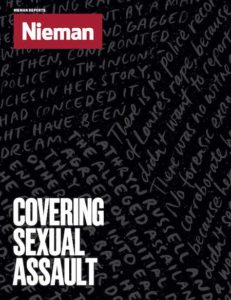 In the Winter issue, our cover story focused on the need for fair, ethical and hard-hitting reporting on sexual assault. The Spring issue focused on the need for diversity in photojournalism. The cover story, “Why We Need More Visual Journalists and Editors of Color,” by 2016 Knight Visiting Nieman Fellow Tara Pixley, was accompanied by a selection of work by photographers seeking to move beyond stereotypical depictions of communities of color.
In the Winter issue, our cover story focused on the need for fair, ethical and hard-hitting reporting on sexual assault. The Spring issue focused on the need for diversity in photojournalism. The cover story, “Why We Need More Visual Journalists and Editors of Color,” by 2016 Knight Visiting Nieman Fellow Tara Pixley, was accompanied by a selection of work by photographers seeking to move beyond stereotypical depictions of communities of color.
Online, highlights included regular columns on media ethics, from 2014 Nieman Fellow Issac Bailey, and on the state of journalism in Mexico (published in both English and Spanish), from 2017 Nieman Fellow Marcela Turati.
Nieman Reports was honored with two awards in 2017: A SFJ Excellence-in-Features Award for the package “Election ’16: Lessons for Journalism” and a Folio Eddie Award for best single article for “Why We Need More Visual Journalists and Editors of Color” by Tara Pixley, as well as honorable mentions for a series of articles (for “Election ’16: Lessons for Journalism”) and a single issue (Fall 2016).
A number of outlets published Nieman Reports articles in 2017: TheAtlantic.com co-published “The Power of Personalization,” which was one of the most popular articles during the week it was posted and drove traffic to the Nieman Reports website; The Guardian picked up 2017 Nieman Fellow Alisa Sopova’s essay “When War Comes Home”; and The Wire, a nonprofit Indian news website, republished “How Venezuela’s Independent Digital News Outlets are Covering Turmoil in Their Country.” Nieman Reports also co-published the results of a Global Reporting Centre study of the power dynamics between fixers and journalists.
The staff that produce Nieman Reports are editor James Geary, deputy curator of the Nieman Foundation; senior editor Jan Gardner; editorial assistant Eryn Carlson; and publisher Ann Marie Lipinski, curator of the Nieman Foundation.
Nieman Lab
Nieman Lab in 2017 continued to provide valuable and innovative coverage of the changing world of digital news to its audience around the globe. In the past 12 months, the Lab has published just over 1,000 articles — a record — written by nearly 200 writers.
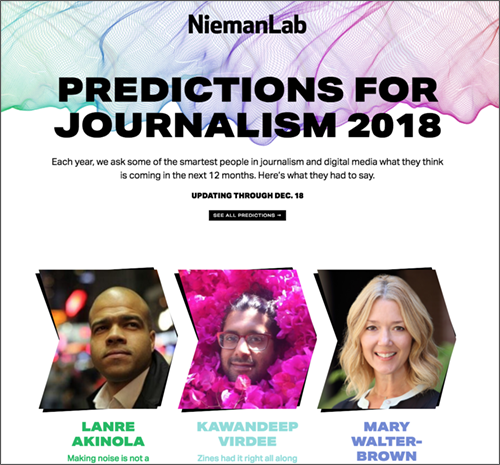 The annual predictions package published in December was the biggest yet, bringing together a diverse group of more than 170 people to write about what the new year would bring. This year, the Lab is offering more media soothsaying with essays by journalists, technologists, academics, and publishers sharing ideas on everything from blockchain to business models, editorial strategy to user research, underserved voices to disinformation campaigns.
The annual predictions package published in December was the biggest yet, bringing together a diverse group of more than 170 people to write about what the new year would bring. This year, the Lab is offering more media soothsaying with essays by journalists, technologists, academics, and publishers sharing ideas on everything from blockchain to business models, editorial strategy to user research, underserved voices to disinformation campaigns.
The Lab covers a wide variety of topics, but a few themes arose this year. Concern continued to grow over the power “the duopoly” — Facebook and Google — have over the news business, with estimates now saying the two companies control 84 percent of global digital ad revenue (excluding China) and are capturing an astounding 186 percent of digital advertising revenue growth.
In large part as a result of those facts, news publishers continued to move away from advertising and toward reader revenue — through subscriptions or memberships — as the key part of their business models. This has worked well for a few companies like The New York Times and The Washington Post, but the record is not as positive for local and regional outlets. And even the best performing digital-native startups, like BuzzFeed, faced layoffs, hurt by their reliance on digital advertising.
In an environment of decreased regulation from the federal government, these underwhelming financial results could easily lead to significant increases in industry consolidation, both in legacy and digital media.
The Lab covered the array of rising platforms that are auditioning to be a key locus of post-smartphone attention — virtual reality, augmented reality, voice interfaces, wearables, and more. It also covered the growing strength of artificial intelligence, both as a reporting tool and as a generator of automated information. Podcasting, one of the few spaces showing unambiguous growth, continued to be a strong area of coverage, primarily through our partnership with Hot Pod’s Nick Quah.
One major initiative in 2016 was the expansion of both its international coverage of journalism innovation and translation of Lab reporting into languages other than English. Supported by a grant from the Open Society Foundations, the Lab worked to have its stories translated and co-published with partner news organizations around the world, including major outlets like the Yomiuri Shimbun, Univision, and the International Center for Journalists. Stories were made available in Portuguese, Spanish, Chinese, Russian, Polish, Arabic, German, and Japanese. A large proportion of Nieman Lab readers have long been from outside the United States (43 percent of website visitors, currently), but now journalists and news executives can be increasingly reached in their native languages.
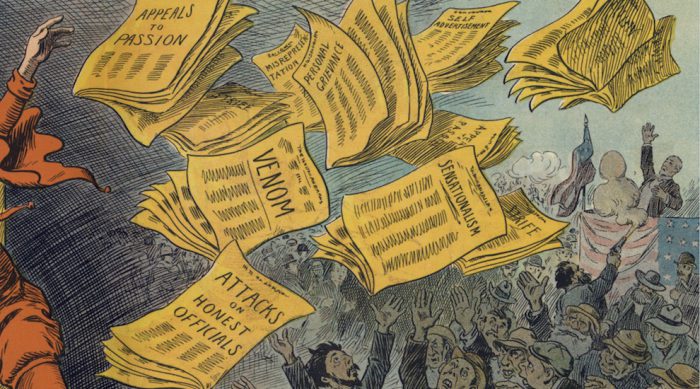
"Real News About Fake News" is a weekly roundup by deputy editor Laura Hazard Owens
The Lab also committed significant resources to reporting on “fake news” — or, to use less tainted terms, misinformation and disinformation. It covered technology companies’ responses to widespread criticism, new academic research on the psychology of news consumption, and startups aiming to tackle the issue. Laura Hazard Owen launched a weekly column titled “Real News About Fake News” which quickly became essential reading for those interested in the topic.
The Nieman Lab team, led by director Joshua Benton, produces daily media coverage with deputy editor Laura Hazard Owen and staff writers Shan Wang and Christine Schmidt, who joined the Lab this year after being its Google News Lab Fellow this summer. New York-based writer Ricardo Bilton is also a key contributor, as are longtime columnist Ken Doctor and Nick Quah.
The Lab’s most important social outreach platform remains email, with the daily and weekly email newsletters reaching over 50,000 people, an increase of nearly 40 percent from a year ago. The Lab’s other social accounts on Twitter, Facebook, and LinkedIn continued to see steady growth in 2017, with over 460,000 followers between then. The site’s articles and other work are read roughly 5 million times per year and viewed many tens of millions of times across social media.
Nieman Storyboard
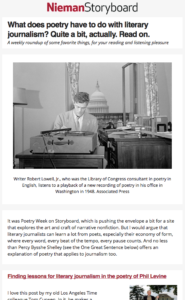 The biggest news of the year for Nieman Storyboard was the launch of the weekly newsletter, a curated list of good reads (and listens) written by editor Kari Howard. Aptly launched on Inauguration Day in the United States, the newsletter now has more than 8,000 subscribers and has increased engagement with readers, many of whom email to say it’s a bright spot in their Friday morning inboxes.
The biggest news of the year for Nieman Storyboard was the launch of the weekly newsletter, a curated list of good reads (and listens) written by editor Kari Howard. Aptly launched on Inauguration Day in the United States, the newsletter now has more than 8,000 subscribers and has increased engagement with readers, many of whom email to say it’s a bright spot in their Friday morning inboxes.
One of last year’s new initiatives, One Great Sentence, continues to do the same for engagement, and a new series, “The Pitch,” which offers tips on pitching longform stories from editors and writers, has attracted readers’ attention.
Some pieces hit a nerve on Storyboard. An example is writer Katherine Boo’s “15 rules for narrative nonfiction,” which went viral. The idea was simple, and contributor Katia Savchuk did a great job with the piece. Storyboard tweeted out each rule, one at a time, and built momentum. It was shared hundreds of times. In September, more than a month after it went live, it still was one of the most-viewed stories on the site.
Storyboard will continue to publish more posts like this: approachable, easy to digest, and, most of all, helpful to our readers.
Some of our goals for the site – to launch new series; spotlight younger writers and freelancers; and to engage with people more through “theme” weeks – have been met with great success this year.
The theme weeks have done a lot to ignite a bit of buzz about the site. So far, we’ve featured Women’s Week, Controversy Week, Gun Violence Week and Movie Week, among others. During Controversy Week, a very moving post by Pulitzer winner Jacqui Banaszynski about the late Alex Tizon’s “My Family’s Slave” did especially well both on Storyboard and social media.
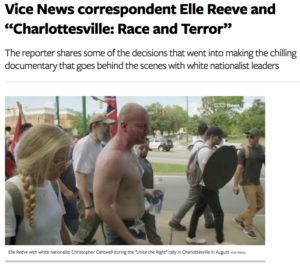 By coincidence, we had a race relations theme week planned at the same time, featuring a Storyboard annotation of Vice News Tonight reporter Elle Reeve’s documentary “Charlottesville: Race and Terror” and a talk that Nikole Hannah-Jones gave at the annual Power of Storytelling conference in Romania. By publishing the stories in quick sequence, we were both timely and topical, which allowed us to be part of the national conversation.
By coincidence, we had a race relations theme week planned at the same time, featuring a Storyboard annotation of Vice News Tonight reporter Elle Reeve’s documentary “Charlottesville: Race and Terror” and a talk that Nikole Hannah-Jones gave at the annual Power of Storytelling conference in Romania. By publishing the stories in quick sequence, we were both timely and topical, which allowed us to be part of the national conversation.
